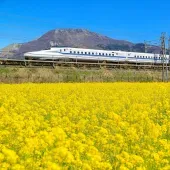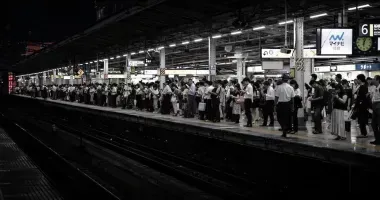Chichibu Railway
The Chichibu Railway is a scenic railway that runs from Mitsumineguchi Station to Hanyu taking in many famous sights of Saitama Prefecture.
The Chichibu Railway is a private railway line that runs from Mitsumineguchi Station in the mountains of far western Saitama Prefecture to Hanyu in central northern Saitama, covering a distance of 71.7 kilometers in total.
The railway runs parallel to the Arakawa River all the way from Mitsumineguchi to Kumagaya. Not always with the river in sight but always within the Arakawa River Valley.
On its route, the Chichibu Railway cuts through much scenic mountainous landscape. That scenery as well as the small, vintage wooden train stations give the line a very nostalgic flair.
On weekends, national holidays and certain weekdays during peak seasons, the Chichibu Railway operates a steam train once a day, the Paleo Express.
According to the Chichibu Railway website, that's the closest steam train to Tokyo. Unlike boarding a steam train in a railway museum, here you can have the experience of riding the real thing, stopping at real stations and actually covering some distance.

Chichibu Railway Train
@Wikimedia
Most Scenic Connection - Seibu Chichibu Line
The most scenic connection to the Chichibu Railway from Tokyo however is the Seibu Ikebukuro / Seibu Chichibu Line combination, also starting out in Ikebukuro. In Hanno, the terminus of the Seibu Ikebukuro Line, you need to change to the Seibu Chichibu Line train.
Shortly after Hanno Station, the Seibu Chichibu Line enters the Koma River Valley. That's a very scenic ride already, offering a good number of stops on the way that give access to sites worth visiting.
From Koma Station, for example, you can easily walk to the Kinchakuda, in late September Japan's biggest higanbana field, or hike up nearby Mount Hiwada which offers great views towards Tokyo's skyscrapers.
From Koma Station, ancient Koma Shrine is also within hiking distance.
Ashigakubo Station on the same line offers access to an artificial ice-covered forest, the Ashigakubo Tsurara, in winter and access to a great number of mountain hiking paths in all hiking seasons.
Yokoze Station finally is the access stop for people who want to hike up Mount Buko, the signature mountain of the Chichibu area.
Red Arrow Express
The Seibu Red Arrow Limited Express travels on the same tracks and goes straight from Ikebukuro to Seibu Chichibu. It's faster (74 minutes from Ikebukuro to Seibu Chichibu) but obviously, as an express train, it doesn't offer the possibilities to explore sites available to the passengers of the local Seibu Chichibu Line.
Both the Seibu Chichibu Line and the Red Arrow Express terminate at Seibu Chichibu Station. Chichibu City itself, an old industrial town turned into a rustic tourist spot, offers many sights including Chichibu Shrine and the Meisenkan silk factory museum.
Riding the Chichibu Railway
From Seibu Chichibu Station it is about a 5 minute walk to Ohanabatake Station, the connecting Chichibu Railway Station.
Like most of the Chichibu Railway stations, Ohanabatake Station is decidedly vintage. A wooden construction erected in 1917, it's an authentic reminder of how Japanese rail travel stations looked like in the days of the steam trains.
Ticket vending machines are available but the Chichibu Railway doesn't accept SUICA or PASMO cards.
From Ohanabatake, you have two options: to go towards Mitsumineguchi in the west or towards Nagatoro, Kumagaya and Hanyu in the northeast.
In direction Mitsumineguchi Station, the train travels through wild mountain areas along the Arakawa River. From Mitsumineguchi Station, you have access to Mitsumine Shrine and the icicles of the Misotsuchi no Tsurara by connecting buses.
Traveling towards Hanyu, you soon get to the remnants of the ancient copper mines of Wadokuroya. A large Wado Kaichin coin replica on the Wadokuroya station platform points out the history of the area. The Wado Kaichin were Japan's first coins, minted here in the early 8th century and used to finance the construction of the then new capital of Japan, Nara.
Nagatoro is not far behind, an especially scenic town, famous for its Funadama River Festival in mid-August, featuring brightly lit riverboats and a giant fireworks. The festival takes place at the Iwadatami, a rock platform adjacent to the Arakawa Gorge, a sight worth visiting all year. At the Iwadatami, riverboat cruises are also available.
Nagatoro is also the access point for Mount Hodo, famous for its views over to the Gunma mountains and for its plum and robai gardens, blossoming in mid-winter.
From Nagatoro, the train continues to Yorii, famous for its River Museum. Eventually, the train arrives at Kumagaya where it connects to the Joetsu and Hokuriku Shinkansen as well as the Takasaki Line.
Kumagaya, an old Nakasendo road station town, is today mostly a mix of industrial and residential areas on the northern periphery of the Tokyo Metropolitan Area. The town's most famous site is the Menuma Shodenzan Temple, a temple rivalling with its elaborate and colorful wood carvings the best in Nikko. In the cherry blossom season from late March to early April, Kumagaya's Arakawa River Park offers great views over to the still snow-covered Mount Asama in neighboring Gunma Prefecture, framed by the blossoming trees along the river walk.
Paleo Express
Chichibu Railway keeps its traditions alive by running a steam train on its line, the Paleo Express.
The Paleo express runs only on weekends, public holidays and certain weekdays in peak vacation season. The Japanese-language website of the Chichibu Railway features a calendar marking each day the train will run. Days marked green are weekdays with the train in operation, pink days are weekends and holidays, orange days indicate special events.
Tickets must be bought or booked in advance. Reserved seat tickets can be purchased at JR East ticket offices.
However, non-reserved seats mean that a seat is not guaranteed. The Chichibu Railway does not accept SUICA or PASMO cards.














